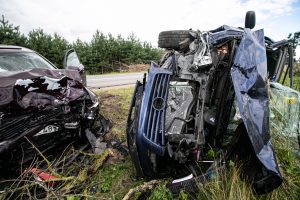 One act can result in both a criminal case and a civil case. A well-known example of this principle is the O.J. Simpson cases. Simpson was found Not Guilty of murder in the criminal case, but he was found liable for wrongful death in the civil case and ordered to pay $8.5 million to the Goldman family. A recent case involving a fatal wreck demonstrates how this principle applies to Ohio cases involving Vehicular Homicide and Vehicular Assault.
One act can result in both a criminal case and a civil case. A well-known example of this principle is the O.J. Simpson cases. Simpson was found Not Guilty of murder in the criminal case, but he was found liable for wrongful death in the civil case and ordered to pay $8.5 million to the Goldman family. A recent case involving a fatal wreck demonstrates how this principle applies to Ohio cases involving Vehicular Homicide and Vehicular Assault.
According to the Greenville News, Nathaniel Hawthorne was stopped for a traffic violation by a state trooper. Hawthorne was speaking with the trooper when a car driven by Allan Zack struck the trooper’s vehicle. The collision knocked Hawthorne into the path of traffic, and Hawthorne was killed. Zack was charged with multiple offenses, including felony DUI resulting in great bodily injury (called Aggravated Vehicular Homicide in Ohio). In addition to the criminal offenses, Zack was also sued by Hawthorne’s mother. The criminal case and the civil case were pursued simultaneously.
The Parties in Civil Cases and Criminal Cases
In any lawsuit, there are basically two parties: a plaintiff and a defendant. In a civil case like the one described above, the plaintiff is the person who claims another person caused harm to the plaintiff by breaching a legal duty. The person accused of breaching the legal duty is the defendant. In the case of a vehicular accident, the plaintiff alleges the defendant had a duty of care and breached that duty by driving negligently. If the victim of the accident is alive, the plaintiff is the victim. If the victim of the accident is deceased, the family (or estate) of the victim is the plaintiff.
In a criminal case, the plaintiff is the government (e.g., the State of Ohio). The government claims the defendant violated a statute: a written law enacted by the legislature. In a case like the one described above, the State of Ohio would prosecute the defendant for violating the Aggravated Vehicular Homicide statute, which prohibits causing the death of another person by operating a vehicle recklessly or under the influence of alcohol and/or drugs.
The Rules in Criminal Cases and Civil Cases
In a civil case, the plaintiff claims the defendant committed a tort. A tort is a wrongful act by one person which causes harm to another person. In Ohio, when a plaintiff sues a defendant for committing a tort, the case is governed by the Ohio Rules of Civil Procedure. The plaintiff must prove the defendant’s negligence by a preponderance of the evidence, which means it is more likely than not the defendant breached a legal duty causing harm to the plaintiff.
In a criminal case, the plaintiff (the State of Ohio) claims the defendant committed a crime. In Ohio, crimes are acts prohibited by the Ohio Revised Code. When the government prosecutes a defendant for committing a crime, the case is governed by the Ohio Rules of Criminal Procedure. The government must prove the defendant’s guilt beyond a reasonable doubt.
The Outcomes in Criminal Cases and Civil Cases
In a civil case, the plaintiff is seeking damages: financial compensation for the harm caused. In a criminal case, the plaintiff (the State of Ohio) is seeking denouncement of the crime, incapacitation of the defendant, punishment of the defendant, rehabilitation of the defendant, and deterrence of the defendant and others.
Ohio Cases Involving Vehicular Assault and Vehicular Homicide
When a driver in Ohio is involved in a serious vehicular accident, the driver may be the defendant in both a civil case and a criminal case. If the victim suffered serious physical harm, the driver may be sued for negligence and charged with the crime of Vehicular Assault. If the victim was killed, the driver may be sued for wrongful death and charged with the crime of Vehicular Homicide. A driver charged with Vehicular Assault or Vehicular Homicide should hire a lawyer with expertise and experience defending clients for serious vehicular crimes.
 Columbus OVI/DUI Attorney Blog
Columbus OVI/DUI Attorney Blog

